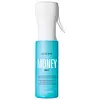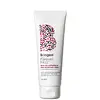What's inside
What's inside
 Key Ingredients
Key Ingredients

No key ingredients
 Benefits
Benefits

 Concerns
Concerns

 Ingredients Side-by-side
Ingredients Side-by-side

Water
Skin ConditioningButylene Glycol
HumectantBehentrimonium Chloride
PreservativeCetyl Alcohol
EmollientPolyquaternium-55
Hydrolyzed Rice Protein
Skin ConditioningAdansonia Digitata Seed Extract
Skin ConditioningAmaranthus Caudatus Seed Extract
Skin ConditioningPropanediol
SolventStearamidopropyl Dimethylamine
EmulsifyingStearyl Alcohol
EmollientDicetyldimonium Chloride
EmulsifyingHydrolyzed Vegetable Protein Pg-Propyl Silanetriol
Skin ConditioningCrambe Maritima Leaf Extract
Skin ConditioningChlorella Pyrenoidosa Extract
Skin ConditioningChondrus Crispus Extract
Skin ConditioningUndaria Pinnatifida Extract
Skin ConditioningLaminaria Saccharina Extract
Skin ProtectingParfum
MaskingCeteareth-20
CleansingCaprylyl Glycol
EmollientPhenoxyethanol
PreservativeCitric Acid
BufferingPotassium Benzoate
PreservativeDimethicone
EmollientPotassium Sorbate
PreservativePropylene Glycol
HumectantSodium Benzoate
MaskingDisodium EDTA
Isopropyl Alcohol
SolventBenzyl Salicylate
PerfumingAlpha-Isomethyl Ionone
PerfumingWater, Butylene Glycol, Behentrimonium Chloride, Cetyl Alcohol, Polyquaternium-55, Hydrolyzed Rice Protein, Adansonia Digitata Seed Extract, Amaranthus Caudatus Seed Extract, Propanediol, Stearamidopropyl Dimethylamine, Stearyl Alcohol, Dicetyldimonium Chloride, Hydrolyzed Vegetable Protein Pg-Propyl Silanetriol, Crambe Maritima Leaf Extract, Chlorella Pyrenoidosa Extract, Chondrus Crispus Extract, Undaria Pinnatifida Extract, Laminaria Saccharina Extract, Parfum, Ceteareth-20, Caprylyl Glycol, Phenoxyethanol, Citric Acid, Potassium Benzoate, Dimethicone, Potassium Sorbate, Propylene Glycol, Sodium Benzoate, Disodium EDTA, Isopropyl Alcohol, Benzyl Salicylate, Alpha-Isomethyl Ionone
Water
Skin ConditioningAloe Barbadensis Leaf Juice
Skin ConditioningPolyquaternium-37
Rosa Canina Fruit Oil
EmollientArgania Spinosa Kernel Oil
EmollientCocos Nucifera Oil
MaskingLaminaria Saccharina Extract
Skin ProtectingBambusa Arundinacea Leaf Extract
Skin ConditioningPanthenol
Skin ConditioningTrametes Versicolor Extract
Tocopheryl Acetate
AntioxidantGlycine Soja Oil
EmollientPropylene Glycol Dicaprylate/Dicaprate
EmollientHydrolyzed Corn Protein
Skin ConditioningHydrolyzed Wheat Protein
Skin ConditioningHydrolyzed Soy Protein
HumectantPPG-1 Trideceth-6
Skin ConditioningSorbitol
HumectantGlycerin
HumectantLeuconostoc/Radish Root Ferment Filtrate
AntimicrobialCitrus Aurantium Dulcis Peel Oil
MaskingCitrus Paradisi Peel Oil
MaskingCitrus Limon Peel Oil
MaskingCitrus Tangerina Peel Oil
MaskingAbies Sibirica Oil
MaskingPolyquaternium-10
Cetrimonium Chloride
AntimicrobialParfum
MaskingDehydroacetic Acid
PreservativeBenzyl Alcohol
PerfumingWater, Aloe Barbadensis Leaf Juice, Polyquaternium-37, Rosa Canina Fruit Oil, Argania Spinosa Kernel Oil, Cocos Nucifera Oil, Laminaria Saccharina Extract, Bambusa Arundinacea Leaf Extract, Panthenol, Trametes Versicolor Extract, Tocopheryl Acetate, Glycine Soja Oil, Propylene Glycol Dicaprylate/Dicaprate, Hydrolyzed Corn Protein, Hydrolyzed Wheat Protein, Hydrolyzed Soy Protein, PPG-1 Trideceth-6, Sorbitol, Glycerin, Leuconostoc/Radish Root Ferment Filtrate, Citrus Aurantium Dulcis Peel Oil, Citrus Paradisi Peel Oil, Citrus Limon Peel Oil, Citrus Tangerina Peel Oil, Abies Sibirica Oil, Polyquaternium-10, Cetrimonium Chloride, Parfum, Dehydroacetic Acid, Benzyl Alcohol
 Reviews
Reviews

Ingredients Explained
These ingredients are found in both products.
Ingredients higher up in an ingredient list are typically present in a larger amount.
We don't have a description for Laminaria Saccharina Extract yet.
Parfum is a catch-all term for an ingredient or more that is used to give a scent to products.
Also called "fragrance", this ingredient can be a blend of hundreds of chemicals or plant oils. This means every product with "fragrance" or "parfum" in the ingredients list is a different mixture.
For instance, Habanolide is a proprietary trade name for a specific aroma chemical. When used as a fragrance ingredient in cosmetics, most aroma chemicals fall under the broad labeling category of “FRAGRANCE” or “PARFUM” according to EU and US regulations.
The term 'parfum' or 'fragrance' is not regulated in many countries. In many cases, it is up to the brand to define this term.
For instance, many brands choose to label themselves as "fragrance-free" because they are not using synthetic fragrances. However, their products may still contain ingredients such as essential oils that are considered a fragrance by INCI standards.
One example is Calendula flower extract. Calendula is an essential oil that still imparts a scent or 'fragrance'.
Depending on the blend, the ingredients in the mixture can cause allergies and sensitivities on the skin. Some ingredients that are known EU allergens include linalool and citronellol.
Parfum can also be used to mask or cover an unpleasant scent.
The bottom line is: not all fragrances/parfum/ingredients are created equally. If you are worried about fragrances, we recommend taking a closer look at an ingredient. And of course, we always recommend speaking with a professional.
Learn more about ParfumWater. It's the most common cosmetic ingredient of all. You'll usually see it at the top of ingredient lists, meaning that it makes up the largest part of the product.
So why is it so popular? Water most often acts as a solvent - this means that it helps dissolve other ingredients into the formulation.
You'll also recognize water as that liquid we all need to stay alive. If you see this, drink a glass of water. Stay hydrated!
Learn more about Water